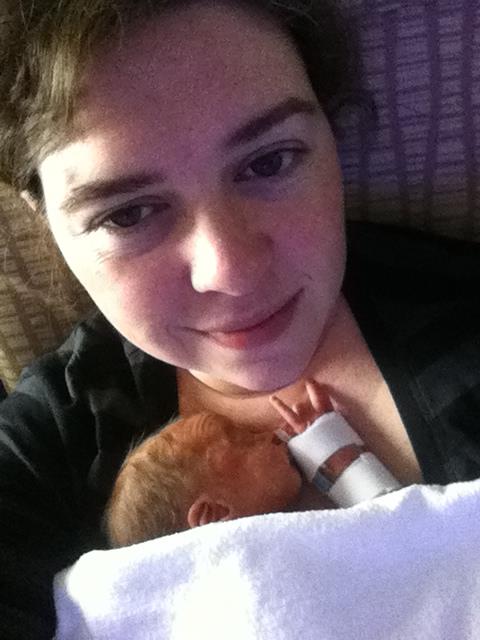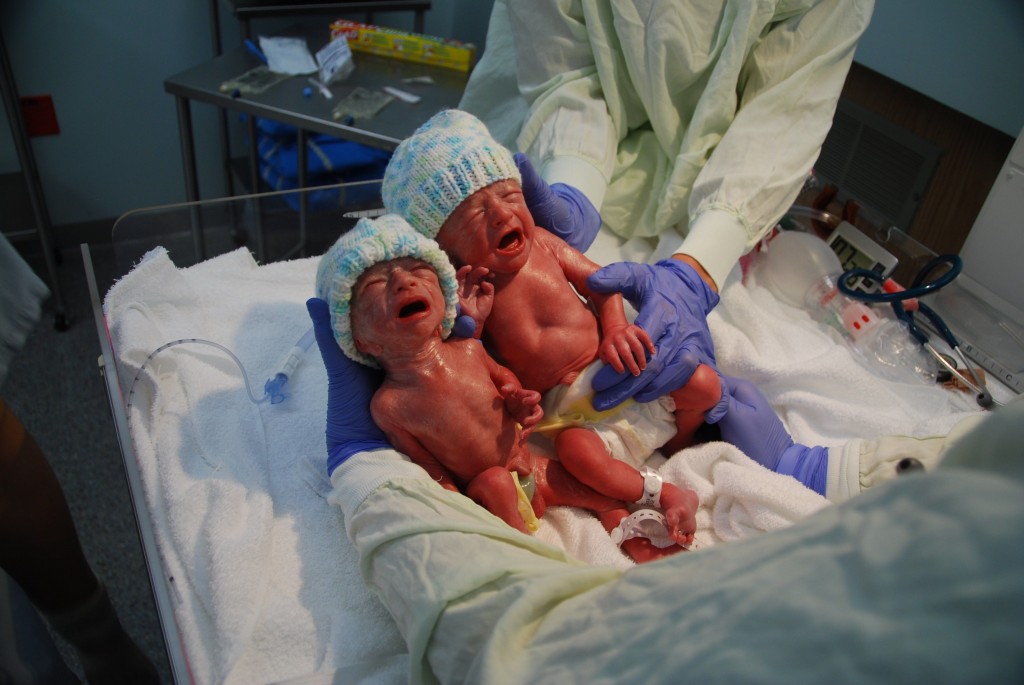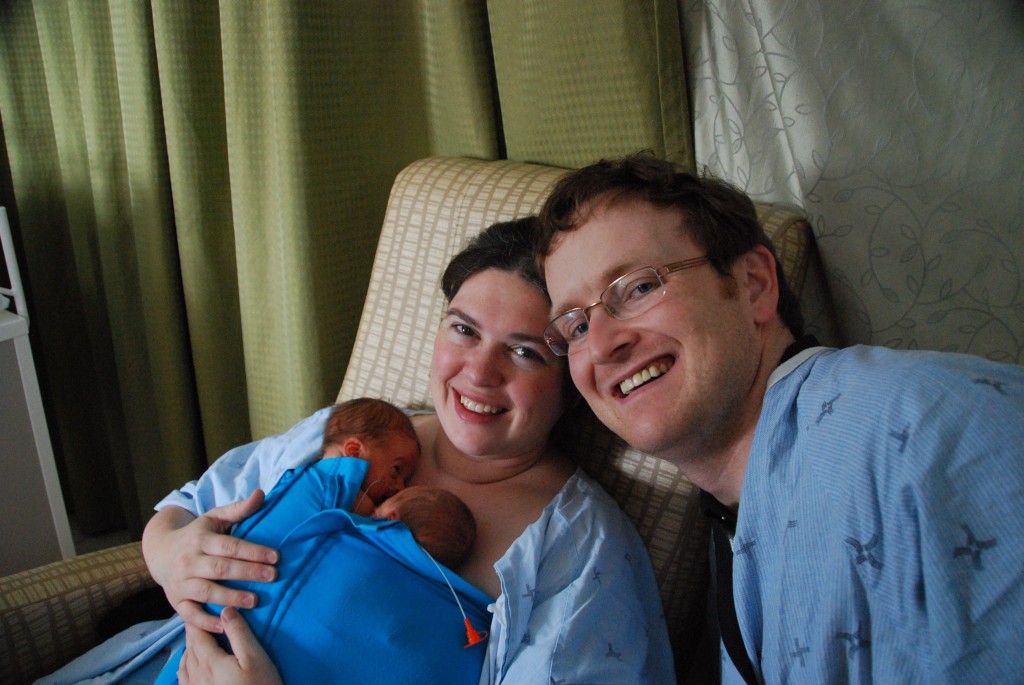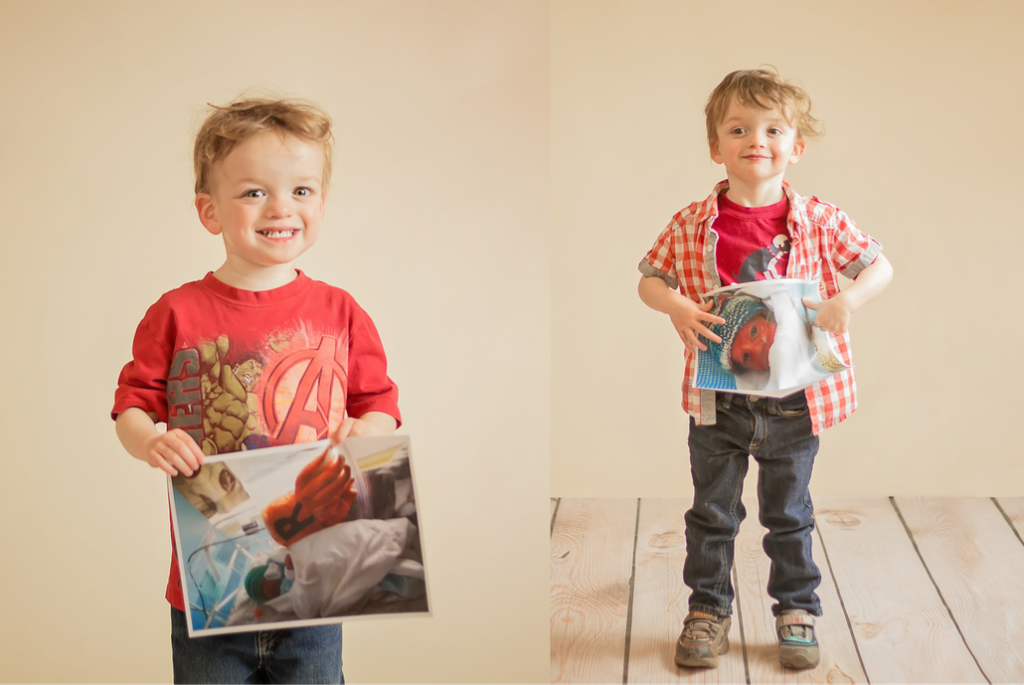
The following is a guest post written by Jenna Morton. Jenna is the creator of Pickle Planet Moncton, a parenting website in New Brunswick, and the mother of three, including twins Rory and Alasdair, who were born at 32 weeks. She often writes about premature birth.

Every hour, at least four more Canadian babies arrive premature – weeks, even months, before their due date. Instead of swaddling blankets and cooing noises, these babies begin life wrapped in tubes and wires, surrounded by monitors and a team of healthcare professionals.
One hour, almost four years ago, this was our journey. Our twin boys, Alasdair and Rory, were born in mid-February. Their original due date was mid-April. That’s two months early – and that’s middle of the pack for preemies. We’ve met other preemies born at our hospital that arrived nearly four months early. Imagine thinking at 20 weeks you’re only halfway through your pregnancy, then one month later holding that tiny spark of life in your arms.

Twenty weeks was a turning point in my pregnancy with the twins. That was when we learned it was twins, not a single baby – and that both boys were in danger of not being born alive at all.
On a Monday, I went for my first ultrasound of the pregnancy. This was our second pregnancy and things seemed to be progressing fine. We didn’t want to know the gender and we were sure (give or take a few days) of the conception date, so we hadn’t felt the need to go for an ultrasound until almost 20 weeks. I often wish we had.
Tuesday, less than 24 hours after learning we were expecting twins, we were called and asked to come to the hospital’s maternal fetal unit. I assumed this was common practice for a multiple birth, but soon learned it was not. Our identical twin boys had developed Twin to Twin Transfusion Syndrome (TTTS) and were at a life-threatening stage. One boy was given a 60% chance of survival without intervention. The other was given a 10% chance of being born.
On Wednesday, my husband and I were on a plane to Toronto, leaving our then-16-month-old daughter with his parents. We met the team at the Special Pregnancy Program at Mount Sinai Hospital and were booked for surgery on Thursday.
TTTS is a disease of the placenta where abnormal blood vessels allow the umbilical cords of two babies to connect, resulting in one twin taking blood and nutrients from the other. One twin suffers decreased blood flow and bladder activity, while the other twin’s heart is strained by the excess he consumes. Performing an in-utero laser surgery to cauterize the connections made by the umbilical cords can improve the chances of survival for both babies.
That Thursday morning my husband and I watched on an overhead screen as Dr. Rory Windrim and Dr. Greg Ryan made a small incision through my abdomen and uterus and cauterized 17 places where the twins’ cords were connecting. Dr. Windrim told us that the average delivery for “laser twins” was 32 weeks.
On Friday, we were discharged. We flew home, cuddled our daughter, and started our follow up appointments with the maternal fetal specialists in Moncton. We waited – for 12 weeks. And at 32 weeks and 2 days, our two boys arrived, kicking and screaming and breathing on their own. That was our dream, and so we actually felt some elation about our premature delivery. That is a luxury not provided to most people who deliver two months before their due date.

Our time in the NNICU was also, despite all the emotional turmoil and intense learning curves, a best case. Our boys were what folks in the business call ‘feeders and growers.’ Within the first few days they were out of the most critical care area, graduated to ‘big boy beds.’ Their hearing and eye tests were not alarming. Their hearts and lungs were fine. They just needed to learn how to eat, so that they could grow. They were 3 pounds, 13 ounces, and 2 pounds, 5.5 ounces. They needed to be close to 5 pounds to come home. That took some time, but in the grand scheme of NNICU stays and life, our 35 days seems like a small number for the impact it’s had on our lives.
Some days I think about all the ‘what ifs.’ What if we’d known sooner we were having twins? What if we’d caught the TTTS sooner? What if we had waited another week for the ultrasound? What if, what if, what if. Mostly I focus on how lucky we were. We didn’t spend months worrying about TTTS or dreaming of a typical twin pregnancy and birth. We were diagnosed in time and had the financial help from family to get to Toronto immediately. Our surgery was a textbook case of the best possible outcome. We hit the 32 week goal we hoped for. Our NNICU switched to a family-based model of care just as we arrived. We didn’t face extra complications and surgeries for our boys. We stayed 35 days and it forever changed our family, but didn’t leave us traumatized. In my mind, we lived a fairy tale.

The next chapter in our fairy tale has been being able to use our positive experience and outcome to help support others who find themselves walking through those big doors at the end of the Maternity Ward hall. My husband and I sat on a steering committee with hospital staff working to improve the care and the patient experience they provide. We volunteer as ‘buddy parents,’ part of a peer support system helping families transition from NNICU life to home. We share our story and raise awareness about premature birth. Because whether you have micro-preemies, feeders and growers, or late-term early arrivals, it’s not something that stops because you’re discharged. It’s part of your life and your child’s life forever.
Premature birth happens to one in 12 Canadian babies. It is the leading cause of infant death in this country. And while there is no cure, there is much that can be done to increase awareness. November 17th is World Prematurity Awareness Day. Wear purple. Share your story. Make sure any pregnant women in your life (and their partners) know the causes and warning signs of premature birth. And hug your kids a bit tighter today, and remember how lucky we all are to make it through the twists and turns of our own fairy tales.

The national group representing premature birth issues in Canada is the Canadian Premature Babies Foundation. You can find them online at http://cpbf-fbpc.org/.
3 thoughts on “Our Preemie Fairy tale: Guest Post by Jenna Morton”
Those little faces. What a story, Jenna. I am so happy for your family!!! <3
I love reading birth stories, especially when they have happy endings! My nephew was a preemie, and I didn’t understand until I was a mother, holding my newborn, and taking her home the next day, just how hard it must have been for my sister to have to leave the hospital without her baby boy.
Yes, I can only imagine how hard that would be! I love birth stories, too. So thankful that Jenna shared her story with us!